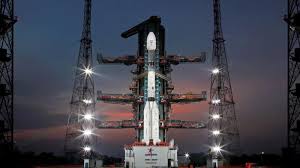ISRO's 100th Launch NVS-02 Satellite Boosts NavIC System
Current Affairs NationalPosted by newadmin on 2025-01-27 17:03:31 |
Share: Facebook | Twitter | Whatsapp | Linkedin Visits: 43

India's space agency, the Indian Space Research Organisation (ISRO), is preparing to mark a significant milestone with its 100th launch. The GSLV-F15 mission, set to launch on January 29, 2025, from the Satish Dhawan Space Centre, will deploy the NVS-02 satellite. This mission is crucial for advancing India's Navigation with Indian Constellation (NavIC), a regional satellite navigation system that is independent and self-reliant.
NavIC Overview
NavIC is India’s own regional navigation system, offering Position, Velocity, and Timing (PVT) services with a primary service area that extends up to 1,500 km beyond Indian borders. NavIC comprises two main service types: Standard Positioning Service (SPS) and Restricted Service (RS). The system’s design ensures a position accuracy of better than 20 meters and timing accuracy of better than 50 nanoseconds. NavIC’s SPS signals are compatible with other global navigation systems such as GPS, Glonass, Galileo, and BeiDou.
Significance of the GSLV-F15 Mission
The GSLV-F15 mission plays a critical role in deploying the NVS-02 satellite, part of the second generation of NavIC satellites. This satellite is designed to replace older satellites in the Indian Regional Navigation Satellite System (IRNSS). The GSLV-F15 mission is expected to last around 19 minutes and is an essential step toward the continued growth and accuracy of India’s navigation system.
NVS-02 Satellite Features
Weighing 2,250 kg at lift-off, the NVS-02 satellite is equipped with advanced atomic clocks to ensure precise timing. It operates on the I-2K bus platform and will be positioned at 111.75ºE to replace the IRNSS-1E satellite. The satellite includes navigation payloads across multiple frequency bands to enhance service delivery.
Advancements in Navigation Technology
The NVS series integrates L1 band signals, aligning with frequencies used by the US Global Positioning System (GPS), thus improving the compatibility of NavIC with smaller devices like fitness trackers. This development is expected to significantly expand the utility and accessibility of the NavIC system.
Challenges and Improvements
The initial IRNSS satellites encountered issues, such as malfunctioning atomic clocks, which required early replacements. The new generation of satellites, including the NVS-02, has been designed to last longer, with an expected operational lifespan of 12 years, addressing these earlier challenges.
Recent Developments in Navigation Services
While there have been criticisms regarding the underutilisation of NavIC services, recent strides have been made. Since 2017, the development of user receivers has gained momentum, with new mobile devices now capable of receiving NavIC signals, broadening its practical applications.
Future of Indian Navigation
The NVS series will consist of five satellites, each aimed at improving the accuracy and reliability of NavIC services. The successful deployment of the NVS-02 satellite marks an important step in enhancing India's navigation capabilities and supporting the country’s growing demand for precise, reliable, and independent navigation services.
Search
Categories
Recent News
- Superstar Krishna Educational Fund: Empowering Young Minds Through Opportunity
- Mahesh Babu Donates Rs 60 Lakh To Chief Minister's Relief Fund For Flood Victims
- Mahesh Babu’s NGO Mahesh Babu Foundation gets FCRA nod
- Every Year, Mahesh Babu Spends ₹30 Crore to Save Children: A Legacy of Compassion and Hope
- Donate Now
- Submit a Request
- Mahesh Babu Foundation Hits 5,000 Heart Surgeries Milestone: A Landmark in Child Healthcare
- Supporting Orphaned Children With Compassionate Giving
Popular News
- Navigating IPO Market Dynamics Amid Volatility and Regulatory Changes
- Innovative Green Practices and Environmental Initiative
- Massive Worldwide Microsoft Outage Disrupts Multiple Sectors
- తెలుగుదేశం పార్టీ - పేదరికాన్ని నిర్మూలించడంలో వాగ్దానం
- Universities Embrace Remote Learning Technologies Amidst Ongoing Pandemic